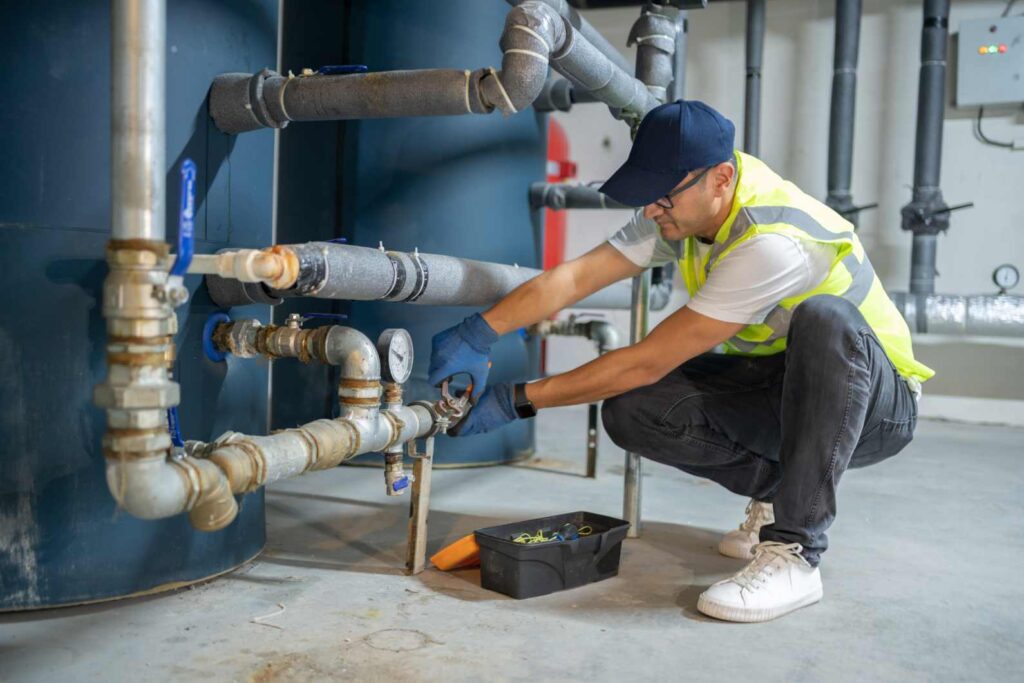
Commercial plumbing and HVAC systems in older buildings can suffer from heat loss, condensation problems, and operational inefficiencies that add up to significant cost overruns. Many facility managers recognize the importance of insulation but may not fully appreciate the role of insulation in HVAC energy efficiency and plumbing protection until an unexpected equipment failure occurs. Triangle Environmental in DuPage County, IL, specializes in evaluating existing infrastructure and recommending comprehensive insulation strategies that address the unique demands of commercial plumbing networks and HVAC systems.
Importance of Proper Insulation in Commercial HVAC Efficiency
Proper insulation goes beyond wrapping pipes and lining ductwork. It’s a cornerstone of any commercial HVAC insulation solutions plan, controlling the rate of heat transfer and reducing load on HVAC compressors and boilers. Insulation supports the equipment by keeping conditioned air contained, decreasing cycling rates, and preventing moisture from forming within mechanical systems. It involves selecting materials and thicknesses suited to high-traffic mechanical rooms, corrosive environments, and fluctuating temperature loads. By integrating HVAC and insulation planning into routine maintenance schedules, businesses can avoid costly emergency repairs, comply with local energy codes, and contribute to sustainability goals through reduced power consumption. Understanding the role of insulating HVAC systems helps facility managers design systems that deliver consistent performance and avoid premature component failures.
Energy Savings
Insulation decreases unwanted heat gain in summer and heat loss in winter, ensuring HVAC systems operate within designed parameters. Reduced thermal bridging directly translates to lower compressor run times and decreased fuel use for boilers. Over the lifetime of insulation, energy savings can account for a substantial portion of operational budgets, often paying back the upfront cost within two to three years.
Equipment Lifespan
By maintaining uniform temperatures around pipes and ductwork, proper insulation prevents stress from thermal expansion and contraction cycles. Stabilizing system temperatures protects sensitive components, such as heat exchangers, compressors, and pumps, from the fatigue that leads to cracks, leaks, or motor burnout. Extending equipment lifespan through insulation reduces capital expenses and minimizes downtime for replacements.
System Performance & Equipment Longevity
When HVAC and insulation are planned in tandem, ductwork remains sealed, and airflow distribution stays balanced across zones. Well-insulated chilled water and refrigerant lines ensure that chillers and cooling towers do not overwork to compensate for heat gain. This integrated approach maintains system performance, reduces wear on controls and valves, and enhances the overall longevity of major equipment assets.
Condensation Control & Corrosion Prevention
Exposed cold surfaces on pipes and ductwork can accumulate moisture, resulting in dripping condensate that damages ceilings and flooring. Moisture also corrodes metal surfaces and creates breeding grounds for mold. A robust insulation strategy eliminates condensation by maintaining surface temperatures above the dew point and by sealing joints to prevent humid air infiltration within commercial refrigeration companies’ cold storage areas.
Safety & Noise Reduction
Insulation materials not only prevent heat loss but also provide sound dampening to reduce mechanical noise from pumps, compressors, and air handlers. Reducing airborne and structural noise enhances occupant comfort and protects hearing in high-noise environments. In addition, thermal insulation serves as a barrier to protect personnel from accidental contact with hot surfaces and minimizes fire spread in the event of an electrical fault.
Improved Indoor Air Quality
Properly installed insulation prevents gaps and voids where dust, dirt, and allergens can accumulate in ductwork. By controlling moisture and preventing microbial growth, insulation contributes to delivering clean, healthy air through the HVAC system. This is particularly important for buildings with cold storage or processing equipment, where humidity control impacts the quality and safety of stored goods.
Environmental Responsibility
Reducing overall energy consumption through effective insulation aligns with green building certifications and local sustainability mandates. Organizations that invest in energy-efficient HVAC and insulation measures demonstrate environmental responsibility and can take advantage of rebate programs for energy-saving upgrades. This proactive approach advances corporate sustainability goals and enhances public perception of the business.
Common Mistakes to Avoid in HVAC Insulation & Sealing
Avoiding installation and HVAC maintenance errors helps ensure that investments in insulation deliver expected performance over time. Recognizing these pitfalls early allows teams to plan for corrections before they incur additional costs:
- Poor Assessment – Skipping a detailed survey of existing insulation R-values, thicknesses, and coverage areas leads to under insulated zones that negate potential savings. A thorough assessment should map every pipe, duct, and equipment surface to determine the exact specifications needed for improved efficiency.
- Low-Quality Materials – Selecting insulation products that degrade under prolonged exposure to heat, UV light, or chemicals results in diminished performance. Commercial-grade materials with proven thermal resistance and durability ratings ensure consistent benefits of insulating HVAC systems in demanding environments.
- Ignoring Maintenance – Over time, physical damage from vibration, rodents, or accidental impacts can create gaps in insulation coverage. Failing to inspect and repair these defects allows heat gain, condensation, and energy waste to resurface, negating initial performance improvements.
Choosing the Right Insulation Strategy
Developing an insulation strategy requires collaboration among engineers, contractors, and maintenance staff to balance cost, compliance, and operational needs. Key factors include material compatibility with plumbing chemicals, required R-value for local climate conditions, fire safety classifications, and accessibility for periodic inspections. By integrating insulation planning into HVAC design and service contracts, businesses can streamline installation, schedule preventative maintenance, achieve measurable savings, and ensure consistent long-term performance.
Call Us for Commercial HVAC Insulation Solutions
Ready to improve system performance and reduce operating costs through professional insulation services? Triangle Environmental serves DuPage County, Kane County, Kendall County, and Will County, IL. Call today to schedule a comprehensive insulation assessment and discover our tailored commercial HVAC insulation solutions.

